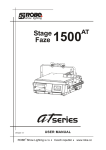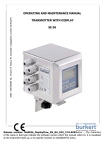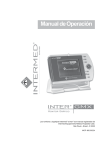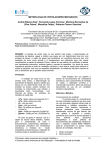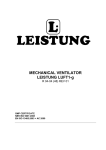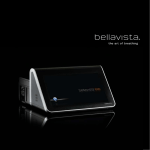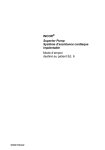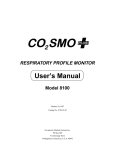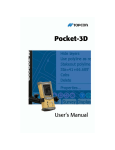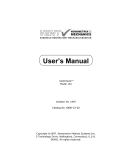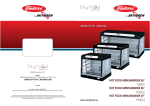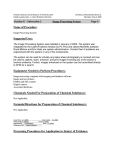Download GMX Monitor User Manual
Transcript
Operation Manual The Intermed® and inter® names and logotypes are registered trademarks of Intermed Equipamento Médico Hospitalar Ltda. São Paulo - Brazil - © 2011 MOP Code 806.00223 Operation Manual ! INTERMED® CAUTION: Read this manual completely before using Inter® GMX Slim on patients. This equipment can be changed without any previous notice to the user. Inter® GMX Slim Operation Manual code 806.00223 Rev. 07 Foreword - 3 Foreword This Operation Manual presents the information required for the correct utilization of Intermed® ventilation graphical monitor, model Inter® GMX Slim. Always use the Operation Manual as reference. Manufacturer: Intermed Equipamento Médico Hospitalar Ltda. Rua Santa Mônica, 980 - Cotia - SP - Brazil - CEP 06715-865 Telephone:+55 (11) 5670 1300 - +55 (11) 4615 9300 Fax: +55 (11) 4615 9310 website: www.intermed.com.br Email: [email protected] CNPJ: 49.520.521/0001-69 - I.E.: 278.188.774.118 After Sales: 0800 770 3357, +55 (11) 5670 1300 or by the website. OBELIS s.a. Boulevard Général Wahis 53 1030 Brussels, BELGIUM Tel: +(32) 2.732.59.54 E-Mail: [email protected] Fax:+(32) 2.732.60.03 ANVISA Product Registration: Technical name: Ventilation Monitor Business Name: Graphical Monitor Inter® GMX Slim Registration Nr.: 10243240040 Product Classification: CEE 93/42 - Medical Device - IIb rule 9 NBR IEC 60601-1:1994 and 1997 amendment; NBR IEC 60601-1-2:2006; NBR IEC 60601-2-12:2004; EN 60601-1:1990/A1:1993/A2:1995 and EN 60601-1-2:2001/ A1:2004; EN 60601-2-12:2006; Equipment Class I / Internally energized Type B applied part - IP24 - Continuous Operation Equipment not appropriate for utilization in the presence of a flammable anesthetic mixture with air, oxygen or nitrous oxide. Technical Responsibility: Eng. Jorge Bonassa CREA 137.189/D INTERMED® Inter® GMX Slim Legal Responsibility: Milton Rubens Salles Operation Manual code 806.00223 Rev. 07 4 - Table of Contents Table of Contents Chapter 1: Introduction ............................................................ 7 Description ................................................................................. 8 Chapter 2: Precautions and Notes.......................................... 9 Chapter 3: Controls and Indicators ...................................... 13 Front Panel ............................................................................... 14 Controls .................................................................................... 15 FREEZE / STAND BY ............................................................... 15 SCREEN SCROLL FORWARD ................................................ 15 SCREEN SCROLL BACKWARD .............................................. 15 POSITION ................................................................................. 15 CONFIRM ................................................................................. 15 MENU ....................................................................................... 15 Graphical Display ...................................................................... 16 ON/OFF Indicator - Power-On/Power-Off ................................... 16 Chapter 4: Assembly .............................................................. 17 Flow sensor connection ............................................................. 18 Chapter 5: Operation .............................................................. 19 Introduction ................................................................................ 20 Initial Screen ............................................................................. 21 Cleaning ................................................................................... 22 Auto Zero .................................................................................. 22 Operation .................................................................................. 23 Parameters Screen ................................................................... 23 Menu Screen ............................................................................. 23 Configuring graphical scales ..................................................... 24 Loop scale screen: .................................................................... 25 Time scale screen: .................................................................... 25 Volume screen: ......................................................................... 25 Flow scale screen: .................................................................... 26 Pressure scale screen: .............................................................. 27 Configuring trend graphical scales ............................................ 27 INTERMED® Inter® GMX Slim Operation Manual code 806.00223 Rev. 07 Table of Contents - 5 PEEP ....................................................................................... 29 PIP ............................................................................................ 29 VTe ........................................................................................... 29 RISNP ....................................................................................... 30 CSTAT ...................................................................................... 30 RR ............................................................................................ 31 Configuring Date and Time ........................................................ 32 Configuring patient data ............................................................ 33 Configuring O2 Analyzer ............................................................. 34 Installation of O2 Cell .................................................................. 35 Preparation for O2 analyzer use ................................................. 35 Cell Calibration ......................................................................... 36 Configuring O2 analyzer alarms .................................................. 37 Monitoring O2 ................................................................................................................................... 38 Erasing data in memory ............................................................ 38 Chapter 6: Troubleshooting .................................................. 39 Chapter 7: Cleaning and Sterilization ................................... 43 Inter® GMX Slim Monitor ............................................................ 44 Oxygen Cell ............................................................................... 45 Flow Sensor .............................................................................. 45 Washing .................................................................................... 46 Chemical Disinfection by Immersion .......................................... 46 Chemical Sterilization by Immersion .......................................... 46 ETO - Ethylene Oxide (C2H4O) ................................................... 47 Chapter 8: Accessories and Parts ........................................ 49 Chapter 9: Preventive Maintenance ...................................... 51 Functional VerificationTest - FVT ............................................... 52 Required Equipment ................................................................. 53 Initial Conditions ........................................................................ 53 Test Sequence - Neonatal sensor .............................................. 54 Test Sequence - Pediatric sensor .............................................. 55 Test Sequence - Adult sensor .................................................... 56 Routine Preventive Maintenance ............................................... 57 Annual Preventive Maintenance - APM ...................................... 58 INTERMED® Inter® GMX Slim Operation Manual code 806.00223 Rev. 07 6 - Table of Contents Chapter 10: Technical Description........................................ 59 Classification ............................................................................ 59 Flow Sensors ............................................................................ 60 Monitors .................................................................................... 61 Alarms ...................................................................................... 61 Graphics ................................................................................... 62 Power Supply ............................................................................ 62 Dimensions and Weight ............................................................ 62 Accessory: O2 concentration sensor .......................................... 63 Electromagnetic levels of compliance ........................................ 63 Chapter 11: Warranty ............................................................. 69 Annex A: Symbols and Terminology .................................... 71 INTERMED® Inter® GMX Slim Operation Manual code 806.00223 Rev. 07 Chapter 1: Introduction - 7 Chapter 1: Introduction ! This Chapter Contains: Always use the ! Description Operation Manual as reference INTERMED® Inter® GMX Slim Operation Manual code 806.00223 Rev. 07 8 - Chapter 1: Introduction Description ! Inter® GMX Slim is a microprocessor-based graphical monitor, coupled and integrated to the Inter® Plus ventilation system ventilators for use on neonatal, pediatric and adult patients. It is recommended for the monitoring of the respiratory mechanics on patients under mechanical ventilation or breathing spontaneously. Inter® GMX Slim uses a high-contrast liquid crystal graphical display enabling excellent visualization both on monochromatic and colorful versions. ! Inter® GMX Slim measures the flow and pressure respiratory parameters by a pneumotachograph with fixed orifice. From the measured signals of flow and pressure, many other relevant parameters are calculated, including inspired and exhaled volumes, complacency, airways resistance, weaning rate, negative inspiratory pressure, among others. ! Inter® GMX Slim incorporates an automatic system to prevent water condensation within pneumotachograph tubes. A selfcalibration routine is periodically performed to enable its continuous utilization. ! Inter® GMX Slim presents the graphical and digital monitoring of the ventilation parameters. Pressure, Flow and Volume Curves due to Time, Pressure vs. Volume, Flow vs. Volume and trend curves facilitate the ventilation monitoring and optimization. ! Inter® GMX Slim also presents an O2 analyzer. Its operation depends on the ventilator controls and cell utilization, and on the optional O2 sensor cable. INTERMED® Inter® GMX Slim Operation Manual code 806.00223 Rev. 07 Chapter 2: Precautions and Notes - 9 Chapter 2: Precautions and Notes ! This Chapter Contains: ! Caution ! Warning ! Notes Inter® GMX Slim shall be handled and operated by qualified and trained personnel, under the direct supervision of a licentiate physician. You must READ THE OPERATION MANUAL COMPLETELY BEFORE using the Inter® GMX Slim on patients. The use of this equipment before its characteristics and functions are fully understood may result in risk conditions to the operator, the patient and the equipment itself. All paragraphs preceded by the following terms deserve special attention: CAUTION: Indicates those conditions that may adversely affect the operator or the patient. ! WARNING: Indicates those conditions that may affect and/or damage the equipment or its accessories. NOTE: Indicates additional information for a better understanding of equipment operation. INTERMED® Inter® GMX Slim Operation Manual code 806.00223 Rev. 07 10 - Chapter 2: Precautions and Notes ! CAUTION: ! Before the first utilization and after using on every patient, or more frequently if required, clean the monitor and sterilize the sensor, according to Chapter 7. ! DO NOT use the equipment in the presence of flammable anesthetic gases, because there is RISK OF EXPLOSION. ! ELECTRIC SHOCK HAZARD: do not disassemble the equipment cabinet. In case of doubts, call Intermed® or the Authorized Technical Service. ! For safety, the screws used for closing are SEALED OFF. Breaking this seals by unauthorized personnel may result in the equipment WARRANTY lost. ! The equipment must be perfectly coupled to a ventilator of Inter® Plus system. ! ALWAYS USE the equipment IN COMPLIANCE WITH THE SPECIFICATIONS included in the manual. In case of doubts, call Intermed® or the Authorized Technical Service. ! NEVER trust the equipment MAINTENANCE to NONAUTHORIZED TECHNICAL PERSONNEL. Contact Intermed® or the Authorized Technical Service in case of any problem or difficulty. ! In case of replacement always use ORIGINAL ACCESSORIES, COMPONENTS AND PARTS, otherwise you can impair equipment performance, patient and operator’s safety, and the warranty validity. ! When Inter® GMX Slim and the respiratory circuit are connected to the patient, a QUALIFIED PROFESSIONAL must be READY to take the required actions whenever an alarm or problem occurs. An ALARM indicates a situation that requires operator attention and SHALL NEVER BE IGNORED. INTERMED® Inter® GMX Slim Operation Manual code 806.00223 Rev. 07 Chapter 2: Precautions and Notes - 11 ! WARNING: ! Perform the FUNCTIONAL VERIFICATION TEST (FVT), specified in the Chapter 9 - Preventive Maintenance, BEFORE THE FIRST UTILIZATION and at least ONCE A MONTH, or always there are DOUBTS on the equipment operation. In case of problems during the FVT, stop the equipment utilization and request corrective maintenance by an authorized technician. ! Do not sterilize the Inter® GMX Slim. The internal components are not compatible with sterilization techniques. ! Follow correctly the instructions for cleaning and sterilizing the components. ! Sterilizing agents containing phenol, ammonium chloride, dimethyl and solutions with a glutaraldehyde concentration higher than 2% can damage the plastic components. ! Inter® GMX Slim maintenance must be performed only by Intermed® or the Authorized Technical Service. ! NOTES: ! The circuit diagrams, component lists, technical descriptions, adjustment and calibration instructions and other required information for the equipment maintenance can be supplied to the customer upon request. ! Inter® GMX Slim is a medical equipment that must be used by specialized personnel under the direct supervision of a physician. ! The use of Inter® GMX Slim in Inter® 3 Plus and Inter® 5 Plus models require optional up grade in this equipment. For further information please contact Intermed® 0800 770 3357. INTERMED® Inter® GMX Slim Operation Manual code 806.00223 Rev. 07 12 - Chapter 2: Precautions and Notes INTERMED® Inter® GMX Slim Operation Manual code 806.00223 Rev. 07 Chapter 3: Controls and Indicators - 13 Chapter 3: Controls and Indicators ! Always use the Operation Manual as reference INTERMED® This Chapter Contains: ! ! ! ! Front Panel Controls Graphical Display ON/OFF Indicator - Power-ON/Power-OFF Inter® GMX Slim Operation Manual code 806.00223 Rev. 07 14 - Chapter 3: Controls and Indicators FRONT PANEL Figure 3.1 . Inter® GMX Slim Front Panel INTERMED® Inter® GMX Slim Operation Manual code 806.00223 Rev. 07 Chapter 3: Controls and Indicators - 15 CONTROLS FREEZE / STAND BY This key enables freezing (stop) the graphic drawing. If it is momentarily pressed (a single touch), the drawing will remain frozen. Press it again to return the graphic monitoring. SCREEN SCROLL FORWARD SCREEN SCROLL BACKWARD These keys enable selecting the monitoring screens available in the Inter® GMX Slim. CONFIRM This key enables confirming the option or adjustment selected. POSITION These keys control the up, down, left and right cursor movement, in order to adjust the monitoring screen. MENU This key accesses the selection menu (task bar). When the menu is accessed, the movement across the various options must be made by the position keys. PRINT (not applicable for the Inter ® GMX Slim model) This key enables printing the selected screen. INTERMED® Inter® GMX Slim Operation Manual code 806.00223 Rev. 07 16 - Chapter 3: Controls and Indicators GRAPHICAL DISPLAY The Inter® GMX Slim graphical display presents the control and monitoring screens. Type : Liquid Crystal Display of active matrix (TFT) Visible area : 115 x 86 mm Resolution : 320 x 240 points ON/OFF INDICATOR - POWER-ON/POWER-OFF In the center top of the Inter® GMX Slim graphical monitor front panel there is the indicator (green led) that will remain lit while the equipment is connected to a power supply. INTERMED® Inter® GMX Slim Operation Manual code 806.00223 Rev. 07 Chapter 4: Assembly - 17 Chapter 4: Assembly ! The correct assembly of Inter® GMX Slim is essential for the perfect equipment operation. ! ! This Chapter Contains: ! Connection of the flow sensors to an Inter® Plus system ventilator. WARNING: The assembly and the operation start-up of this equipment must be performed by an Intermed® qualified technician or by the Authorized Technical Service. NOTE: The correct operation of Inter® GMX Slim depends on the perfect connection of flow sensors in an Inter® Plus system ventilator. INTERMED® Inter® GMX Slim Operation Manual code 806.00223 Rev. 07 18 - Chapter 4: Assembly FLOW SENSOR CONNECTIONS Figure 4.1 - Detail of the flow sensors connection on the side panel of an Inter® Plus system ventilator. INTERMED® Inter® GMX Slim Operation Manual code 806.00223 Rev. 07 Chapter 5: Operation - 19 Chapter 5: Operation ! Follow correctly the instructions included in this manual to achieve the best equipment performance. INTERMED® This Chapter Contains: ! Introduction ! Initial Screen ! Operation Inter® GMX Slim Operation Manual code 806.00223 Rev. 07 20 - Chapter 5: Operation INTRODUCTION 1. Clean the monitor and sterilize the sensor, according to Chapter 7. 2. Select the proper flow sensor - neonatal, pediatric or adult: Sensor Neonatal - Clearance 0.8mL Pediatric - Clearance 0.8mL Adult - Clearance 7mL Patient Flow: 0.2 to 9 L/min Flow: 2 to 24 L/min Flow: 6 to 120 L/min 3. Connect the sensor to an Inter® Plus system ventilator and to the “Y” connection of the patient circuit, according to Figures 4.3 or 4.5 contained in the Assembly Chapter of the Manual for this equipment. 4. Power-on the ventilator according to the instructions in the Operation Manual. ! CAUTION: ! The equipment must be handled and operated by qualified and trained personnel under the direct supervision of a licentiate physician. ! The use of this equipment before its characteristics and functions are fully understood may result in risk conditions for the operator, the patient and the equipment itself. INTERMED® Inter® GMX Slim Operation Manual code 806.00223 Rev. 07 Chapter 5: Operation - 21 INITIAL SCREEN When the equipment is poweredon, the initial screen informs the software revision, the flow sensor connection condition and the type used, with the following information: ! DISCONNECTED SENSOR Indicates that there is no sensor connected to the monitor. ! NEONATAL SENSOR CONNECTED Indicates that the neonatal sensor is connected to an Inter® Plus system ventilator. In this case, the monitor assumes the calibration configurations and the neonatal range scale. ! PEDIATRIC SENSOR CONNECTED Indicates that the pediatric sensor is connected to an Inter® Plus system ventilator. In this case, the monitor assumes the calibration configurations and the pediatric range scale. ! ADULT SENSOR CONNECTED Indicates that the adult sensor is connected to an Inter® Plus system ventilator. In this case, the monitor assumes the calibration configurations and the adult range scale (not applicable to Inter® 3 Plus/NEO ventilators). ! TRANSMISSION OFF Indicates that there is no signal between the Inter® GMX Slim ventilator and monitor. Contact Intermed® or the authorized technical service. If the sensor is connected, the monitor will leave the initial screen after 5 seconds and will start the Cleaning and Auto Zero resources. INTERMED® Inter® GMX Slim Operation Manual code 806.00223 Rev. 07 22 - Chapter 5: Operation ! NOTE: After exhibiting the initial screen, the equipment presents the last screen displayed before it has been powered-off. CLEANING At every 5 minutes the equipment eliminates eventual liquids existing within both sensor measurement duct paths. ! CAUTION: Perform the cleaning of the sensor duct when there are solid residues inside it, in order to prevent that the sensor accuracy is affected. AUTO ZERO At every 5 minutes the equipment repositions the flow zero indication in order to assure the accuracy during the monitoring period. ! NOTE: During the Cleaning and Auto Zero routine (25 seconds), an interval in the monitoring occurs. INTERMED® Inter® GMX Slim Operation Manual code 806.00223 Rev. 07 Chapter 5: Operation - 23 OPERATION Parameter Screen Press FORWARD or BACKWARD keys to display the parameter change screen. This screen displays all information related to the patient in terms of the respiratory mechanics, as well as the indication of the oxygen alarm cause (low or high concentration). Respiratory parameter screen Menu Screen Press the MENU key to start the access to the controls and screens available in the Inter® GMX Slim. The menu screen presents the available control functions: INTERMED® FUNCTION DESCRIPTION SET UP Enables configuring date and time, the digital visualization of the flow and pressure for calibration purposes, the patient data and data cleaning. TREND SCALE Enables configuring the trend graphical scales. GRAPH SCALE Enables configuring the pressure, flow, volume and time scales, and the loop of graphics displayed on the screens. Inter® GMX Slim Operation Manual code 806.00223 Rev. 07 24 - Chapter 5: Operation Press the direction keys to access each command. Press the center key in the command area (CONFIRM) to select the commands. CONFIGURING GRAPHICAL SCALES 1. Press the MENU key to activate the function. 2. Press the direction key ! to to open the scale options: PRESSURE, FLOW, VOLUME, TIME or LOOP. 3. Press the direction key " to select the scale: 20, 40 or 120 hPa. 4. Press CONFIRM key to validate the selected scale. 5. Adjust the other scales following the steps above for every function of item 2, using the direction keys # and/or " in order to select, and ! when selected. INTERMED® Inter® GMX Slim Operation Manual code 806.00223 Rev. 07 Chapter 5: Operation - 25 LOOP SCALE SCREEN: This screen enables to select the loop scale, defining the period after which the loop is updated. It can be at every: - 1 cycle - 2 cycles - 4 cycles Select the desired scale and press CONFIRM key. In order to view the graphic screen, press FORWARD or BACKWARD keys until this screen appears: TIME SCALE SCREEN: This screen enables to select the time scale, defining the window scanning period that can be: - 5 sec - 10 sec - 20 sec This configuration is applicable to Pressure vs. Flow and Pressure vs. Volume graphics. As lower the scanning time is, greater the graphic reading resolution will be. VOLUME SCREEN: This screen enables to select the proper volume scale in order to assure a better graphic visualization. The values depend on the sensor used: Neonatal Sensor: - 20 mL - 40 mL - 80 mL Pediatric Sensor: - 100 mL - 200 mL - 500 mL Adult Sensor: - 500 mL - 1000 mL - 2000 mL Select the desired scale and press the CONFIRM key. INTERMED® Inter® GMX Slim Operation Manual code 806.00223 Rev. 07 26 - Chapter 5: Operation In order to view the graphic screen, press FORWARD or BACKWARD keys until the presented screen appears: Pressure vs. Volume graphic screen FLOW SCALE SCREEN: This screen enables to select the most suitable flow scale, in order to assure a better graphic visualization. The values depend on the sensor used. Neonatal Sensor: - 3 L/min - 6 L/min - 9 L/min Pediatric Sensor: - 8 L/min - 16 L/min - 24 L/min Adult Sensor: - 40 L/min - 80 L/min - 120 L/min Select the desired scale and press the CONFIRM key. In order to view the graphic screen, press FORWARD or BACKWARD keys until the screen aside appears: Pressure vs. Flow graphic screen INTERMED® Inter® GMX Slim Operation Manual code 806.00223 Rev. 07 Chapter 5: Operation - 27 PRESSURE SCALE SCREEN: This screen enables to select the most suitable pressure scale, in order to assure a better graphic visualization: - 20 hPa, 40 hPa or 120 hPa Select the desired scale and press the CONFIRM key. In order to view the graphic screen, press FORWARD or BACKWARD keys until the screen aside appears: Pressure vs. Volume graphic screen CONFIGURING TREND GRAPHICAL SCALES ZOOM Feature: The trend graphs may be presented in scales from 15 minutes, 1, 2, 4, 8, 12 up to 24 hours, by using the ZOOM function. If the gathered data is not erased it remains in system memory for 24 hours. Open the trend graph by moving the # or ! directional keys. Use the " or $ keys to open or close the time window of the trend graph intended. INTERMED® Inter® GMX Slim Operation Manual code 806.00223 Rev. 07 28 - Chapter 5: Operation 1. Press the MENU key on the control panel to activate the functions. 2. Press the directional key " to select the TREND SCALE function. 3. Press the direction key ! to open the scale options menu: ERASE, PEEP, PIP, VTe, RINSP, CSTAT or RR 4. Press the directional key " to select the parameter to be configured. 5. Press the CONFIRM key to confirm the selected scale. 6. Adjust the other scales, following the steps above for every function of item 2, using the direction keys # and/or " in order to select, and ! when selected. INTERMED® Inter® GMX Slim Operation Manual code 806.00223 Rev. 07 Chapter 5: Operation - 29 PEEP (Positive End-Expiratory Pressure) The PEEP function enables adjusting the expiratory pressure scale visualization mode in 10, 20 or 50 hPa. PIP (Positive Inspiratory Pressure) The PIP function enables adjusting the inspiratory pressure scale visualization mode in 20, 40 or 120 hPa. VTe (Total Expiratory Volume) The VTe function enables adjusting the Total Expiratory Volume scale visualization mode according to the sensor used: Neonatal Sensor: - 80 mL - 40 mL - 20 mL INTERMED® Inter® GMX Slim Pediatric Sensor: - 500 mL - 200 mL - 100 mL Adult Sensor: - 2000 mL - 1000 mL - 500 mL Operation Manual code 806.00223 Rev. 07 30 - Chapter 5: Operation RISNP (Inspiratory Resistance) The RISNP function enables adjusting the inspiratory resistance scale visualization mode according to the sensor used: Neonatal Sensor: - 200 hPa/L/s - 100 hPa/L/s - 50 hPa/L/s Pediatric Sensor: - 200 hPa/L/s - 100 hPa/L/s - 50 hPa/L/s Adult Sensor: - 100 hPa/L/s - 50 hPa/L/s - 20 hPa/L/s CSTAT (Static Compliance) The CSTAT function enables adjusting the static compliance scale visualization mode according to the sensor used: Neonatal Sensor: - 5 mL/hPa - 10 mL/hPa - 20 mL/hPa INTERMED® Inter® GMX Slim Pediatric Sensor: - 5 mL/hPa - 10 mL/hPa - 20 mL/hPa Adult Sensor: - 20 mL/hPa - 50 mL/hPa - 100 mL/hPa Operation Manual code 806.00223 Rev. 07 Chapter 5: Operation - 31 RR ( Respiratory Rate) The RR function enables adjusting the respiratory rate scale visualization mode in 30, 60 or 180 min-1. To view the trend screens, press the page FORWARD or BACKWARD keys until the following screens are displayed: PEEP and CSTAT trend screen VTe and RR trend screen PIP and RINSP trend screen INTERMED® Inter® GMX Slim Operation Manual code 806.00223 Rev. 07 32 - Chapter 5: Operation CONFIGURING DATE AND TIME 1. Press the MENU key and use the direction key " to select the SET UP option. 2. Press the direction key ! to access the SET TIME option in order to configure date and time, and open the configuration window. 3. Adjust each field (year, month, day, hour and minutes) using the direction key ". 4. Press the CONFIRM key to change field and to return to the previous menu. The time can be configured in the formats: - 12-hour (AM/PM) - 24-hour (default) Move the cursors # and ! to select each field. Move the cursors " and $ to change them. ! NOTE: Keeping the " or $ keys pressed, the values are changed more quickly. The date can be configured in the formats: month in the numeric format (01 to 12) (default). months abbreviated in English: JAN FEB MAR APR MAY JUN JUL AUG SEP OCT NOV DEC INTERMED® - January - February - March - April - May - June - July - August - September - October - November - December Inter® GMX Slim Operation Manual code 806.00223 Rev. 07 Chapter 5: Operation - 33 The exhibition order can be presented in the following options: - mm/dd/yyyy - dd/mm/yyyy Where: dd : day (2 digits) mm : month (2 digits) yyyy : year (4 digits) To leave the configuration screen press the MENU key, or the FORWARD or BACKWARD keys. CONFIGURING PATIENT DATA 1. Press the MENU key on the control panel to activate the menu on the monitor screen. 2. Press the directional key " to select the SET UP option. 3. Press the direction keys ! and " to select the PATIENT option (patient data configuration). 4. Open the data entry screen with the direction key !. To enter data in the fields, select the characters to compose words or numbers using the direction keys, and confirm their entry with the CONFIRM key. - NAME - up to 25 characters; - AGE - up to 03 characters; - SEX - M (male) or F (female) with the directional keys; - WEIGHT - up to 03 characters. INTERMED® Inter® GMX Slim Operation Manual code 806.00223 Rev. 07 34 - Chapter 5: Operation Special characters: - &: spaces between words in the same field - <: backward movement to any field - >: forward movement to any field - *: Reset (clears all information. Confirm the option with the CONFIRM key). ! NOTE: Keeping the "and $ keys pressed, the values are changed more quickly. Press the CONFIRM key to go to the next field. Press the MENU key to return to main menu. CONFIGURING THE O2 ANALYZER The Inter® GMX Slim presents an O2 analyzer. This operation is made together with the ventilator controls and will only be performed when using the O2 Cell (optional). ! NOTE: ! For the perfect operation of this mode, install the O2 Cell and proceed according to the Operation, Assembly and Calibration instructions described in this section. ! In order to operate correctly, the ventilator blender must be fed by one 100%-oxygen gas supply and one 21%-oxygen medical air supply. INTERMED® Inter® GMX Slim Operation Manual code 806.00223 Rev. 07 Chapter 5: Operation - 35 INSTALLATION OF O2 Cell Install the O2 Cell according to the drawing below: 1) Connect the cable terminal in the O2 Cell entry located in the ventilator rear panel. 2) Connect the O2 Cell in the ventilator side panel, fitting the female side in the Inspiratory branch output, before connecting the Insp. tube of the patient circuit. 3) Fit the Insp. tube of the patient circuit in the male side of the O2 Cell. Figure 5.1 - Fitting diagram of O2 Cell PREPARATION FOR O2 ANALYZER USE ! NOTE: Keep the circuit disconnected from the patient. 1. Connect the O2 Cell cable in the ventilator, according to previous description. 2. Make sure that the gas supplies are connected and under the working pressures described in the ventilator’s Operation Manual. 3. Obstruct the patient circuit “Y”. 4. Power-on the ventilator with the Inter® GMX Slim connected, and set the following parameters in the commands: Mode Sensitivity by pressure Insp. Time Flow Resp. Rate P Limit : Time Cycle A/C : (Exp. Flow: - - ) : 1.00 sec : 30 L/min : 30 min-1 : 20 hPa (cmH2O) 5. The ventilator starts to cycle. INTERMED® Inter® GMX Slim Operation Manual code 806.00223 Rev. 07 36 - Chapter 5: Operation CELL CALIBRATION 1. In the Inter® GMX Slim graphical monitor, press the MENU key and select the SET UP mode using the direction key ". 2. Use the direction keys ! and " until select O2 ANALYZER. 3. Use the direction key ! to access the calibration and adjustment screen. 4. Check the “PRESS ENTER TO START CALIBRATION” message in the information frame. 5. Press the CONFIRM key to start the calibration. 6. Adjust 21% in the ventilator blender and press the CONFIRM key. Wait until the end of the visualization bar course in the monitor. This time will be of approximately 1 min and 30 sec, after which the “OK” message will be displayed. 7. Now, adjust 100% in the ventilator blender and repeat the operation. The calibration is done. ! NOTE: The following failure conditions may occur during the calibration: ERROR Error occurrence due to wearing or O2 Cell defect. CELL Disconnected Operation not feasible due to O2 Cell disconnection. ABORT INTERMED® When you press MENU the calibration operation is aborted. In this case, the calibration will be kept with the data of the last calibration performed or the factory default. Inter® GMX Slim Operation Manual code 806.00223 Rev. 07 Chapter 5: Operation - 37 CONFIGURING O2 ANALYZER ALARMS 1. Still in the calibration screen, select the SET ALARM function using the direction keys # or !. In the monitor central command, adjust the LOW (low saturation) and HIGH (high saturation) alarms. 2. Once the alarm is chosen, use the direction keys " or $ to select the alarm value for LOW and HIGH, according to the scale: LOW: from 18 to 99%-concentration HIGH: from 19% to OFF 3. Press the MENU key in the monitor command to finish. ! NOTE: ! The O2 analyzer alarm is presented by a visual indication $ in the monitor graphical display and by an audible signal in the ventilator. - medium priority signal: from 18% to 100% O2 concentration - high priority signal: O2 concentration equal or less than 18% ! To silence an alarm caused by the O2 analyzer, press SILENCE/ RESET in the ventilator. MESSAGES AREA During the alarms calibration and configuration processes, the following information can be displayed in the message area: INTERMED® OK Indicates correct calibration ERROR Calibration out of the defined parameter ABORT Calibration aborted MUST BE BELOW Indicates that the minimum O2 % alarm cannot HIGH ALARM be equal or greater than the maximum O2 % alarm MUST BE ABOVE Indicates that the minimum O2 % alarm cannot LOW ALARM be equal or greater than the minimum O2 % alarm Cell disconnected Indicates that the O2 cell is not connected Inter® GMX Slim Operation Manual code 806.00223 Rev. 07 38 - Chapter 5: Operation MONITORING O2 The O2 monitoring is displayed in the parameter screen of the Inter® GMX Slim graphical monitor. The set alarms are indicated by the " symbol in the lower right corner of the working screens. When an alarm is triggered, the letters “L” (LOW) or “H” (HIGH) will flash in the left side of the O2 value, and an audible alarm in the ventilator will be activated until it is disabled by the SILENCE/RESET key in the ventilator. When the alarm is silenced, the symbol will appear and the letters “L” (LOW) or “H” (HIGH) will stop flashing when the alarm cause is removed. Press SILENCE/RESET in the ventilator to erase the signal. ERASING DATA IN MEMORY 1.Press the MENU key on the control panel to activate the menu on the monitor screen. 2. To erase the data stored in the memory as patient data and TREND, select the CLEAR DATA option using the direction key ", and press CONFIRM. 3. Then, the “DELETE DATA? YES / NO?” confirmation request will appear. With the direction key ! select: - “YES” to erase data - “NO” to return to the main menu without erasing data. 4. When the YES option is pressed, the monitor will present the respiratory parameters monitoring screen with the default configuration. ! INTERMED® NOTE: The time and date data are not affected, but they return to the default exhibition format (24-hour time format, and date in the numeric format dd/mm/yyyy). Inter® GMX Slim Operation Manual code 806.00223 Rev. 07 Chapter 6: Troubleshooting - 39 Chapter 6: Troubleshooting ! This Chapter Contains: ! Troubleshooting array Some problems can be solved by the user. ! INTERMED® WARNING: Whenever a problem cannot be solved by the operator, stop using the equipment and contact Intermed® 0800 770 3357. Inter® GMX Slim Operation Manual code 806.00223 Rev. 07 40 - Chapter 6: Troubleshooting PROBLEM The screen displays the message “TRANSMISSION OFF” The screen displays the message “DISCONNECTED SENSOR” PROBABLE CAUSE CORRECTIVE ACTION 1. Monitor disconnected of the ventilator. 1. Check the connection fitting. 2. Electronic failure. 2. Contact the Authorized Technical Service. 1. Misconnected or disconnected flow sensor in the ventilator. 1.Connect the appropiate flow sensor in the ventilator. 1. Flow sensor disconnected from the patient circuit. 1. Connect the sensor in the patient’s circuit. 2. Leakage in patient’s circuit. 2. Remove the circuit leakage. Monitor does not update therespiratory parameters; 3. Leakage in the flow sensor connection. Monitor does not displayflow and/or pressurecurves; 4. Flow sensor tube blocked; secretion Monitor displaysflow accumulation on the flow and/or pressurecurves sensor or within the distortedand/or sensor tube. attenuated. 5. Defective flow sensor. The indicated values of flow and/or curves exceeded the scale limits. INTERMED® 3. Reconnect the sensor in the monitor, replace the sensor. 4. Remove the blocking and/or clean the flow sensor tube. 5. Replace the flow sensor. 6. Electronic problem. 6. Stop using the equipment and contact the Authorized Technical Service. 1. Improper selection of the neonatal/pediatric flow sensor. 1. Replace the sensor for the pediatric/ adult model. 2. Secretion accumulation on the sensor. 2. Clean the flow sensor. Inter® GMX Slim Operation Manual code 806.00223 Rev. 07 Chapter 6: Troubleshooting - 41 PROBLEM Exhaled volume less than the inspired volume. The pressure and/or flow curves present noises. Expiratory Flow Volume and Peak flashing. PROBABLE CAUSE CORRECTIVE ACTION 1. Endotracheal tube leakage. 1. Remove leakages. 2. Water and/or secretion accumulation on the flow sensor and/or within the sensor tube. 2. Clean the flow sensor and/or the sensor tube. 3.Miscalibrated flow sensor. 3. Replace the flow sensor. 4. Defective self-cleaning system. 4. Contact Intermed® or the Authorized Technical Service. 5. Miscalibrated monitor. 5. Contact Intermed® or the Authorized Technical Service. 1. Water and/or secretion accumulation within the patient’s circuit. 1.Remove the water from the circuit; clean secretions. 2. Secretion accumulation within the endotracheal tube. 2. Aspirate the secretions from the endotracheal tube. 1. Flow limit exceeded (e.g., using the neonatal/pediatric sensor). 1. Reduce the work flow. Inspiratory Flow Volume and Peak flashing. Fail Calibration INTERMED® 1. Calibration out of the± 10 % range. Inter® GMX Slim 2. Replace the neonatal/ pediatric sensor by the pediatric/ adult sensor. 1.Contact Intermed® or the Authorized Technical Service. Operation Manual code 806.00223 Rev. 07 42 - Chapter 6: Troubleshooting INTERMED® Inter® GMX Slim Operation Manual code 806.00223 Rev. 07 Chapter 7: Cleaning and Sterilization - 43 Chapter 7: Cleaning and Sterilization ! The components durability and the patient safety depend on the proper cleaning and sterilization. ! This Chapter Contains: ! Monitor ! Flow sensor ! Oxygen Cell WARNING: ! Before using the equipment for the first time and after its use on every patient, or more frequently when required, clean the equipment and sterilize the flow sensor. ! After the sterilization, rinse and dry properly the flow sensor in order to eliminate any residual chemical substances. INTERMED® Inter® GMX Slim Operation Manual code 806.00223 Rev. 07 44 - Chapter 7: Cleaning and Sterilization INTER® GMX SLIM MONITOR Cleaning and disinfection of the monitor outer parts, except for the control panel, may be done with an appropriate germicidal or bactericidal agent. The control panel may be cleaned with a gauze humidified with 70% Isopropyl Alcohol. ! WARNING: ! NEVER sterilize the monitor. ! NEVER place the monitor in a liquid solution. ! NEVER use abrasives on the monitor surface. ! NEVER allow liquid to enter inside the monitor. ! NEVER use alcohol for the rear panel cleaning, because the lettering can be damaged. THE DISINFECTION is a process capable of destroying pathogenic microorganisms, BUT IT CANNOT destroy the spores. The spores are only destroyed by STERILIZATION. INTERMED® Inter® GMX Slim Operation Manual code 806.00223 Rev. 07 Chapter 7: Cleaning and Sterilization - 45 OXYGEN CELL ! WARNING: ! Use ONLY a clean and dry rag for the oxygen cell cleaning. ! NEVER use any substance for the cell cleaning, because it can be damaged. FLOW SENSOR Material Processes Neonatal Sensor - code 136.00347 (Silicone/Polycarbonate) L, D, EQ, ETO Pediatric Sensor - code 136.00311 (Silicone/Polycarbonate) L, D, EQ, ETO Adult Sensor - code 136.00310 (Silicone/Polycarbonate) L, D, EQ, ETO Caption: L: Washing D: Chemical Disinfection by Immersion EQ: Chemical Sterilization by Immersion ETO: Ethylene Oxide INTERMED® Inter® GMX Slim Operation Manual code 806.00223 Rev. 07 46 - Chapter 7: Cleaning and Sterilization WASHING BEFORE performing any disinfection or sterilization process, washing by immersion should be carried out in a neutral solution with enzymatic detergent, at a temperature between 35oC and 65oC, for approximately 10 minutes. Rinse with distilled or filtered water to eliminate the high concentrations of chemical substances used. Leave to dry in a clean environment before proceeding with the disinfection or sterilization. ! WARNING: DO NOT USE Phenol (>5%) Chlorinated Hydrocarbons Ketones Aromatic Hydrocarbons Formaldehyde Inorganic Acids Hypochlorite Ammonium Quaternary Compounds These solutions may cause cracks on polysulfone components or disintegration of silicone tubes. Do not use these solutions in washing processes that precede sterilization in autoclave and pasteurization, since they can accelerate materials deterioration. CHEMICAL DISINFECTION BY IMMERSION Chemical disinfection by immersion can be performed using a 2% Glutaraldehyde solution (Cidex®) for a period of 40 MINUTES. Rinse with distilled and sterilized water to eliminate the high concentrations of chemical substances used. Let it dry in a clean environment. CHEMICAL STERILIZATION BY IMMERSION Chemical sterilization by immersion can be performed using a 2% Glutaraldehyde solution (Cidex®) for a period of 12 HOURS. Rinse with distilled and sterilized water to eliminate the high concentrations of chemical substances used. Let it dry in a clean environment. INTERMED® Inter® GMX Slim Operation Manual code 806.00223 Rev. 07 Chapter 7: Cleaning and Sterilization - 47 ETO - ETHYLENE OXIDE (C2H4O) The sterilization using Ethylene Oxide gas must comply with EN ISO 11135-1:2007 standard. ! WARNING: ! NOTE: ! After sterilizing in Ethylene Oxide, await from 24 to 48 hours before using the material, in order to enable aeration and exit of gas residues. ! Components submitted to sterilization suffer natural degradation due to the characteristics of the processes used. The sensor lifetime will depend on the care in its utilization and handling. ! Do not use sensors that have damage or deterioration signals. INTERMED® Inter® GMX Slim Operation Manual code 806.00223 Rev. 07 48 - Chapter 7: Cleaning and Sterilization INTERMED® Inter® GMX Slim Operation Manual code 806.00223 Rev. 07 Chapter 8: Accessories and Parts - 49 Chapter 8: Accessories and Parts ! This Chapter Contains: ! Accessories, Components and Parts. Always use original accessories and parts. ! CAUTION: ! In case of replacement always use ORIGINAL ACCESSORIES AND PARTS, otherwise you can impair the equipment performance, patient and/or user’s safety, and warranty validity. INTERMED® Inter® GMX Slim Operation Manual code 806.00223 Rev. 07 50 - Chapter 8: Accessories and Parts Accessories and Parts The accessories and parts of Inter® Plus model ventilators used with the Inter® GMX Slim graphical monitor are listed below: Code 151.00000 Description Inter GMX Slim Graphical Monitor Optional Accesories 151.00900 O2 sensor cable and oxygen cell Optional Accesories (ventilator) ! 136.00347 Neonatal Flow Sensor 136.00311 Pediatric Flow Sensor 136.00310 Adult Flow Sensor NOTE: ! The accessories required for the Inter® GMX Slim operation are connected to the ventilator. INTERMED® Inter® GMX Slim Operation Manual code 806.00223 Rev. 07 Chapter 9: Preventive Maintenance - 51 Chapter 9: Preventive Maintenance ! Always use original accessories and parts. ! This Chapter Contains: ! Functional Verification Test - FVT ! Routine Preventive Maintenance ! Annual Preventive Maintenance - APM WARNING: In order to prevent premature equipment wear and to achieve a safe performance within the required specifications, the following should be made: ! Routine Preventive Maintenance It must be carried out DAILY or before each use, according to this chapter instructions. ! Functional Verification Test - FVT It must be performed at least MONTHLY, or in case of doubts on the equipment operation. ! Annual Preventive Maintenance - APM Request the equipment checking, adjustment and calibration ANNUALLY, performed by Intermed ® or by Authorized Service. INTERMED® Inter® GMX Slim Operation Manual code 806.00223 Rev. 07 52 - Chapter 9: Preventive Maintenance FUNCTIONAL VERIFICATION TEST - FVT The FVT is a test that enables to verify if the equipment is operating in accordance with specifications. The FVT must be performed by the operator at least once a month, or in case of doubts on the ventilator operation. When detecting problems during the FVT, the equipment must be removed for corrective maintenance. Contact Intermed® 0800 770 3357. The O2 analyzer calibration must be done at every patient change, and must follow the conditions established in Chapter 5: Operation. ! CAUTION ! The equipment must be DISCONNECTED FROM THE PATIENT for FCT conduction. ! The equipment that is not operating IN ACCORDANCE TO THE SPECIFICATIONS CONTAINED IN THE MANUAL SHOULD NOT BE USED. Contact Intermed® 0800 770 3357. ! NEVER TRUST the equipment maintenance to NONAUTHORIZED PERSONNEL. Contact Intermed® 0800 770 3357 in case of any problem or difficulty. INTERMED® Inter® GMX Slim Operation Manual code 806.00223 Rev. 07 Chapter 9: Preventive Maintenance - 53 REQUIRED EQUIPMENT For the FVT conduction, the following equipment are required: - Intermed® ventilator model Inter® Plus. - Intermed® Lung Simulator model LS2000 or similar. ! WARNING: In order to assure the accuracy of the measures taken, it is required that the ventilator used is calibrated by traceable measurement equipment, under metrological standards worldwide recognized, and in compliance with the requirements of the ISO 9001:2008 Quality system rules. In case of doubts, please contact Intermed® 0800 770 3357. INITIAL CONDITIONS 1. The Inter® GMX Slim graphical monitor and the ventilator must be properly assembled, according to Chapter 4; 2. The monitor and the ventilator must be disconnected from the patient; 3. Assemble the patient circuit in the ventilator. 4. Connect the ventilator to the power mains under the proper voltage, and to the grounding system for protection. 5. Connect the ventilator to the proper pneumatic pipeline (Air and oxygen pressure at 350 kPa). INTERMED® Inter® GMX Slim Operation Manual code 806.00223 Rev. 07 54 - Chapter 9: Preventive Maintenance TESTS SEQUENCE - NEONATAL SENSOR 1. Connect the neonatal sensor to the ventilator and to the patient’s circuit (between the lung simulator and the circuit’s Y connection), according to Chapter 4. 2. Power-on the ventilator. Check if the sensor ID on the Inter® GMX Slim initial screen is correct: NEONATAL SENSOR CONNECTED. Access the monitoring screen. 3. Adjust the simulator to 50 hPa (cmH2O)/L/s of resistance and 20mL/ hPa (cmH2O) of compliance. Adjust the following ventilator parameters: Mode Cycle Inspiratory Flow Expiratory Flow Inspiratory Time Respiratory Rate Resulting I:E Ratio PEEP Inspiratory Pressure (threshold) : Controlled Time : Assisted/Controlled : 6 L/min : 2 L/min : 1.00 sec : 30 min-1 : 1:2 : 0 hPa (cmH2O) : 80 hPa (cmH2O) (maximum) 4. Check on the Inter® GMX Slim monitor if the indicated values for Inspiratory Pressure Peak, PEEP, Airways Average Pressure MEAN, Inspiratory Flow Peak Pif, Respiratory Rate RATE, Inspiratory Time Tinsp, and I:E Ratio (I:E RATIO) are in compliance with the values programmed and indicated in the ventilator. 5. Check if the values for Vol insp and Vol exp displayed on the Inter® GMX Slim monitor are 100ml ± 10ml. 6. Check if the pressure, flow and volume curves are compatible with the ventilation parameters and the ventilation mode selected in the ventilator. 7. Adjust the alarm thresholds compatible with the parameters adjusted in the ventilator. Change the parameters adjusted in the ventilator in order to generate alarm conditions, checking their actuation in the monitor. INTERMED® Inter® GMX Slim Operation Manual code 806.00223 Rev. 07 Chapter 9: Preventive Maintenance - 55 TESTS SEQUENCE - PEDIATRIC SENSOR 1. Connect the pediatric sensor to the ventilator and to the patient’s circuit (between the lung simulator and the circuit’s Y connection), according to Chapter 4. 2. Power-on the ventilator. Check if the sensor ID on the Inter® GMX Slim initial screen is correct: PEDIATRIC SENSOR CONNECTED. Access the monitoring screen. 3. Adjust the simulator to 50 hPa (cmH2O)/L/s of resistance and 20mL/cmH2O of compliance. Adjust the following ventilator parameters: Mode : Controlled Time Cycle : Assisted/Controlled Inspiratory Flow : 15 L/min Expiratory Flow : 5 L/min Inspiratory Time : 1.00 sec Respiratory Rate : 20 min-1 Resulting I:E Ratio : 1:2 PEEP : 5 hPa (cmH2O) Inspiratory Pressure (threshold) : 120 hPa (cmH2O) (maximum) 4. Check on the Inter® GMX Slim monitor if the indicated values for Inspiratory Pressure Peak, PEEP, Airways Average Pressure MEAN, Inspiratory Flow Peak Pif, Respiratory Rate RATE, Inspiratory Time Tinsp, and I:E Ratio (I:E RATIO) are in compliance with the values programmed and indicated in the ventilator. 5. Check if the values for Vol insp and Vol exp displayed on the Inter® GMX Slim monitor are 250mL ± 25mL. 6. Check if the pressure, flow and volume curves are compatible with the ventilation parameters and the ventilation mode selected in the ventilator. 7. Adjust the alarm thresholds compatible with the parameters adjusted in the ventilator. Change the parameters adjusted in the ventilator in order to generate alarm conditions, checking their actuation in the monitor. INTERMED® Inter® GMX Slim Operation Manual code 806.00223 Rev. 07 56 - Chapter 9: Preventive Maintenance TEST SEQUENCE - ADULT SENSOR 1. Connect the adult sensor to the ventilator and to the patient’s circuit (between the lung simulator and the circuit’s Y connection), according to Chapter 4. 2. Power-on the ventilator. Check if the sensor ID in the Inter® GMX Slim initial screen is correct: ADULT SENSOR CONNECTED. Access the monitoring screen. 3. Adjust the simulator to 20 hPa (cmH2O)/L/s of resistance and 50mL/cmH2O of compliance. Adjust the following ventilator parameters: Mode Cycle Volume Inspiratory Flow Respiratory Rate PEEP : Controlled Volume : Assisted/Controlled : 500mL : 30 L/min : 15 min-1 : 5 hPa (cmH2O) 4. Check on the Inter® GMX Slim monitor if the indicated values for Inspiratory Pressure (Peak), PEEP, Airways Average Pressure MEAN, Inspiratory Flow Peak Pif, Respiratory Rate RATE, Volume Exp. and I:E Ratio (I:E RATIO) are in compliance with the values programmed and indicated in the ventilator. 5. Check if the pressure, flow and volume curves are compatible with the ventilation parameters and the ventilation mode selected in the ventilator. 6. Adjust the alarm thresholds compatible with the parameters adjusted in the ventilator. Change the parameters adjusted in the ventilator in order to generate alarm conditions, checking their actuation in the monitor. INTERMED® Inter® GMX Slim Operation Manual code 806.00223 Rev. 07 Chapter 9: Preventive Maintenance - 57 ROUTINE PREVENTIVE MAINTENANCE Daily or prior to using: 1. Check the integrity of flow sensor, sensor tubes and power cable, and their proper connection, as per described in the Chapter 4; 2. Check the integrity of the patient circuit; eliminate possible leakages due to the assembly, or replace the circuit if necessary; 3. Check the equipment’s general status so as to ensure that it did not suffer any falls or damages that might compromise its safe working; request for Intermed® or Authorized Technical Service technical support in case of doubts or problems; 4. Check the equipment’s cleaning status proceeding in accordance with Chapter 7; 5. Sterilize the patient’s circuit according to Chapter 7 and/or the institution’s procedures; Monthly: Conduct the Functional Verification Test - FVT, requesting technical support from Intermed® 0800 770 3357 in case of problems. Annually: Request for the Annual Preventive Maintenance - APM, including verification, adjust and calibration of the equipment, to Intermed® or the Authorized Technical Service. INTERMED® Inter® GMX Slim Operation Manual code 806.00223 Rev. 07 58 - Chapter 9: Preventive Maintenance ANNUAL PREVENTIVE MAINTENANCE- APM The Annual Preventive Maintenance - APM is an exclusive service provided by Intermed® in order to assure the safe operation of the equipment, in compliance with the original specifications and requirements of the NBR IEC 60601-1:1994 and 1997 amendment; NBR IEC 60601-2-12:2004; EN 60601-1:1990/A1:1993/A2:1995 and EN 60601-2-12:2006 rules. The APM consists basically of the check of all equipment functions, replacement of defective parts or components that present wear or deterioration due to use, and adjustment and calibration of the equipment. The calibration is performed with traceable measurement equipment under metrological standards worldwide recognized, and in compliance with the requirements of the ISO 9001/2008 Quality System rules. The following conditions are applied: 1. The customer should send the equipment for APM to Intermed® or Intermed® Authorized Service after using the equipment for 12 months. In case of doubts, please contact Intermed® 0800 770 3357; 2. The APM should be performed at Intermed® or Intermed® Authorized Service facilities, with the customer being responsible for freight; 3. When performed within the WARRANTY period, the conditions established in Chapter 11 will be applicable. 4. APM is limited to the equipment; accessories are not included. INTERMED® Inter® GMX Slim Operation Manual code 806.00223 Rev. 07 Chapter 10: Technical Description - 59 Chapter 10: Technical Description ! Always use the Operation Manual as reference. This Chapter Contains: ! ! ! ! ! ! ! Classification Flow Sensors Monitors Alarms Graphics Power Supply Dimensions and Weight CLASSIFICATION According to the type of protection against electric shock Class I / Internally Energized Equipment According to the type of protection against electric shock Type B applied part According to the type of protection against noxious dripping water IP24 According to the operation mode Continuous Operation Equipment not suitable for use in the presence of a flammable anesthetic mixture with air, oxygen or nitrous oxide. NBR IEC 60601-1:1994/A1:1997; NBR IEC 60601-1-2:2006; NBR IEC 60601-2-12:2004; EN 60601-1:1990/A1:1993/A2:1995; EN 60601-1-2:2001/A1:2004; EN 60601-2-12:2006; CEE 93/42 Medical Device - Class IIb rule 9 ! INTERMED® NOTE: All measured values are expressed in BTPS (Body Temperature and Pressure, Saturated). Inter® GMX Slim Operation Manual code 806.00223 Rev. 07 60 - Chapter 10: Technical Description FLOW SENSORS Range Tolerance Neonatal Clearance (internal volume): 0.8mL 0.2 to 9 ±5% or 0.2 L/min Pediatric Clearance (internal volume): 0.8mL 2 to 24 ±5% or 0.5 L/min 6 to 120 ±5% or 2 L/min Adult Clearance (internal volume): 7mL Maximum deviation according to gas composition (at 100% O2, calibrated sensor to 21% O2) < 4% Maximum deviation according to gas temperature ! See the graph below: NOTE: Flow sensors are accessories of the Inter® Plus model. Measured Volume / Actual Volume Volume - Temperature Ratio ! Temperature (°C) INTERMED® Inter® GMX Slim Operation Manual code 806.00223 Rev. 07 Chapter 10: Technical Description - 61 Monitors Maximum Inspiratory Pressure Peak Plateau Pressure Plateau PEEP PEEP Mean Airway Pressure Mean Inspiratory Peak Flow Pif Expiratory Peak Flow Pef Tidal Inspiratory Volume Vol insp Tidal Expiratory Volume Vol exp Minute Volume Vol min Respiratory Rate Rate Inspiratory Time Tinsp I:E Ratio I:E Ratio Inspiratory Resistance Rinsp Expiratory Resistance Rexp Dynamic Compliance Cdyn Static Compliance Cstat Weaning Index RSBI Negative Inspiratory Pressure NIP Ventilation Work (ventilator) WOBvent O2 Analyzer Alarms Visual signalling on the monitor and medium-priority audible alarm in the ventilator. INTERMED® Low oxygen concentration (Low %02) 18% to 99% High oxygen concentration (High %02) 19% to OFF Inter® GMX Slim Operation Manual code 806.00223 Rev. 07 62 - Chapter 10: Technical Description Graphics - Curves Pressure vs. Time Flow vs. Time Volume vs. Time Pressure vs. Volume Flow vs. Volume Graphics - Trends (24 hours-maximum period of data) Maximum Inspiratory Pressure Expiratory Volume Respiratory Rate Inspiratory Resistance Compliance PEEP Power Supply 12 V Direct Current 0.25 A Dimensions and Weight INTERMED® Height (H) 175 mm Width (W) 250 mm Depth (D) 143 mm Weight 1 kg Inter® GMX Slim Operation Manual code 806.00223 Rev. 07 Chapter 10: Technical Description - 63 Accessory: O2 Concentration Sensor Type of sensor Galvanic Cell Measurement Range from 0 to 100% for 90% response < 15s for 97% response < 25s Above the range of operating temperature 2.0% At constant temperature and pressure 1.0% Response Time Accuracy (% of full-scale) Operating Temperature 0° to 40° C (32° to 104° F) Storage Temperature -15° to 50° C (5° to 122° F) Operating Humidity (non-condensed) 0 to 95% Usage Time 900.000 h / % O2 Stability (above 8 hours of use, at constant temperature and pressure) <1 Electromagnetic Emission GMX® is designed for use in an electromagnetic environment as specified below. The GMX® client or user must assure that it is used in such environment. Compliance Guidelines - Electromagnetic Environment RF emission CISPR 11 Group 1 GMX® uses RF energy only for its internal functions. This RF emission is very low and must not cause any interference in electronic devices close to it. RF emission CISPR 11 Class A Harmonic emission IEC 61000-3-2 Class A Tension Fluctuation/Flickers emission IEC 61000-3-3 Comply Emission Test INTERMED® Inter® GMX Slim GMX® is appropriate to be used in all places, including domestic places and those directly connected to a short tension public power main supplying energy for domestic purposes. Operation Manual code 806.00223 Rev. 07 64 - Chapter 10: Technical Description Electromagnetic Immunity GMX® is designed for use in an electromagnetic environment as specified below. The GMX® client or user must assure that it is used in such environment. Immunity Test Test Level IEC 60601 Compliance Level Surge IEC 61000-4-5 Tension Dips, Short Tension interruptions and differences in the power mains inlet tension IEC 61000-4-11 Electromagnetic field at the power supply frequency (50/60 Hz) IEC 61000-4-8 INTERMED® The floor must be made of wood, concrete or ceramics. If the floor is made of a synthetic material, the relative humidity must be 30%, at least. ± 6 kV ± 6 kV ± 8 kV ± 8 kV ± 2 kV for power supply line ± 2 kV for power supply line ± 1 kV for inlet and outlet line ± 1 kV for inlet and outlet line ± 1kV from line to line ± 1kV Diferential Mode ± 2kV from line to grounding ± 2kV Common Mode < 5 % UT (>95% dip at UT) for 0.5 cycle 40 % UT (60% dip at UT) for 5 cycles 70 % UT (30 % dip at UT) for 25 cycles <5 % UT (>95% dip at UT) for 5 seconds < 5 % UT (>95% dip at UT) for 0.5 cycle 40 % UT (60% dip at UT) for 5 cycles 70 % UT (30 % dip at UT) for 25 cycles <5 % UT (>95% dip at UT) for 5 seconds The power mains quality must be standard for commercial or hospital environment. 0.3 A/m If a distortion occurs, GMX® may need to be positioned far from the magnetic sources or it will be necessary to place magnetic shields. The magnetic field must be measured in the place intended for the placement and it must be assured that it is weak enough. Electrostatic Discharge IEC 61000-4-2 Electric Transient Fast/Surge IEC 61000-4-4 Electromagnetic Environment Guide 3 A/m Inter® GMX Slim The power mains quality must be standard for commercial or hospital environment. The power mains quality must be standard for commercial or hospital environment. Operation Manual code 806.00223 Rev. 07 Chapter 10: Technical Description - 65 ! NOTE FOR ELECTROMAGNETIC COMPATIBILITY: This equipment was developed, tested and certified in accordance with the thresholds established in NBR IEC 60601-1-2:2006 and EN 60601-1-2:2001/A1:2004 for Class I / Internally Powered electromedical equipment, and CEE 93/42 - Medical Device Class IIb rule 9, following CISPR 11 normative conditions. The thresholds are intended to offer protection against prejudicial interferences in its installation and operation, according to the immunity levels defined for electromagnetic interferences for the equipment connected on patient, as per technical description and use in conformity with this manual. When exposed to situations adverse to its specification, this equipment can produce or suffer electromagnetic interference. In order to prevent prejudicial interferences it is mandatory to: - Observe the distances between this equipment and other possible EMI emitters; - Only connect the equipment to a grounded outlet for protection; - Never disable the grounding terminal on the power cable plug of the equipment (ventilator). In case of doubts, always contact Intermed® or the Authorized Technical Service. Restrictions: The non-authorized modification of any elements or components which operation can be affected by electromagnetic fields voids the product warranty and can produce adverse operating results. Do not operate the equipment out of the described conditions and in a magnetic resonance environment, or near to high frequency surgical equipment, defibrillators or short wave therapy equipment. The electromagnetic interference may impair this equipment operation. INTERMED® Inter® GMX Slim Operation Manual code 806.00223 Rev. 07 66 - Chapter 10: Technical Description Manufacturer's guidelines and statement - electromagnetic immunity GMX® is designed for use in an electromagnetic environment as specified below. The GMX® client or user must assure that it is used in such environment. Immunity test IEC 60601 TEST LEVEL Compliance level Electromagnetic environment - guidelines Portable and mobile RF communication equipment must not be used close to any GMX® component, including cables with distance lower than that recommended, calculated from the equation applicable to the transmitter frequency. Recommended Separation Distance d = 1.2SP RF Conducted IEC 61000-4-6 10 Vrms 150 kHz up to 80 MHz on ISM bandsa 10 Vrms RF Radiated IEC 61000-4-3 10 V/m 80 MHz up to 2.5 GHz 10 V/m d = 1.2SP 80 MHz up to 800 MHz d = 2.3SP 800 MHz up to 2.5 GHz where P is the maximum outlet nominal strength of the transmitter in watts (w), according to the manufacturer's transmitter, and d is the recommended separation distance in meters (m)b. It is recommended that the field intensity from the RF transmitter, as determined by electromagnetic inspection at the placec, to be lower than the compliance level in each frequency range.d Interference may occur close to the equipment marked with the following symbol: NOTE 1 In 80 MHz and 800 MHz, the highest frequency range must be applied. NOTE 2 These guidelines may not be applied to all situations. The electromagnetic propagation is affected by the absorption and reflection of structures, objects and people. a b c d The ISM bands (industrial, medical and scientific) between 150 kHz and 80 MHz are 6.765 MHz up to 6.795 MHz; 13.553 MHz up to 13.567 MHz; 26.957 MHz up to 27.283 MHz; and 40.66 MHz up to 40.70 MHz. The compliance level in the ISM frequency bands between 150 kHZ and 80 MHz and in the frequency range between 80 MHz up to 2.5 GHz is intended to reduce the probability of mobile and portable communication equipment to cause interference if brought, inadvertently, to the patient environment. Therefore, an additional 10/3 factor is used to calculate the distance separation recommended to transmitters in those frequency ranges. The field intensity established by fixed transmitters, such as base radio station, telephone (mobile/wireless), land mobile radios, amateur radio, AM and FM radio transmission and TV transmission, cannot be accurately predicted. To evaluate the electromagnetic environment due to fixed RF transmitters, it is recommended to consider an electromagnetic inspection of the place. If the field intensity measurement at the place where GMX® is used exceeds the above applicable RF compliance level, the observation of GMX® is recommended to check if the operation is Normal. If an unusual performance is observed, additional procedures may be necessary, such as a new orientation or new positioning of GMX®. Above the frequency range from 150 kHz to 80 MHz, the field intensity is recommended to be lower than 3 V/m. INTERMED® Inter® GMX Slim Operation Manual code 806.00223 Rev. 07 Chapter 10: Technical Description - 67 Recommended separation distance between mobile and portable RF communication equipment and GMX®. GMX® is designed for use in an electromagnetic environment in which RF disturbances are controlled. The GMX® client or user may help preventing electromagnetic interference by keeping a minimal distance between mobile and portable RF communication equipment (transmitters) and GMX®, as recommended below according to the maximum outlet strength of the communication equipment. Separation distance according to the transmitter frequency m Transmitter maximum outlet strength W 150 kHz up to 80 MHz out of ISM bands 150 kHz up to 80 MHz in the ISM bands d = 1.2 SP d = 1.2 SP 0.01 0.12 0.1 80 MHz up to 800 MHz 800 MHz up to 2,5 GHz d = 1.2 SP d = 2.3 SP 0.12 0.12 0.23 0.38 0.38 0.38 0.73 1 1.2 1.2 1.2 2.3 10 3.8 3.8 3.8 7.3 100 12 12 12 23 For transmitters with a maximum outlet nominal strength not listed above, the recommended separation distance d in meters (m) may be determined by using the equation applicable to the transmitter frequency, where P is the transmitter maximum outlet nominal strength in watts (W), according to the transmitter manufacturer. NOTE 1 In 80 MHz and 800 MHz, the separation distance for the highest frequency range is applied. NOTE 2 The ISM bands (industrial, medical and scientific) between 150 kHz and 80 MHz are 6.765 MHz up to 6.795 MHz; 13.553 MHz up to 13.567 MHz; 26.957 MHz up to 27.283 MHz; and 40.66 MHz up to 40.70 MHz. NOTE 3 An additional 10/3 factor is used to calculate the distance separation recommended to transmitters in the ISM bands between 150 kHZ and 80 MHz and in the frequency range between 80 MHz up to 2.5 GHz to reduce the probability of mobile and portable communication equipment to cause interference if brought, inadvertently, to the patient environment. NOTE 4 These guidelines may not be applied to all situations. The electromagnetic propagation is affected by the absorption and reflection of structures, objects and people. INTERMED® Inter® GMX Slim Operation Manual code 806.00223 Rev. 07 68 - Chapter 10: Technical Description INTERMED® Inter® GMX Slim Operation Manual code 806.00223 Rev. 07 Chapter 11: Warranty - 69 Chapter 11: Warranty ! Read the warranty conditions attentively. In case of doubts or problems, always request for assistance from the authorized representative. Intermed Equipamento Médico Hospitalar Ltda. products are warranted against material and manufacturing defects and meet the published characteristics. The warranty and technical assistance are assured by Intermed Equipamento Médico Hospitalar Ltda. and its Authorized Service throughout Brazilian territory and in countries where the Authorized Service is instituted. The responsibility for the warranty is limited to replacement, repair and labor, at the manufacturer’s discretion, for components presenting defect or not meeting the characteristics published during the warranty period. The warranty does not cover defects caused by accident, improper use, use conditions, improper installation or sterilization, service, installation, operation or alteration performed by non-authorized or unqualified personnel. For safety, the screws used for closing are SEALED OFF. Breaking this seals by unauthorized personnel may result in the equipment WARRANTY lost. Components subject to normal wear or degradation through use, adverse use conditions, negligent use or accidents are not covered by the WARRANTY. The established warranty period is of 12 months for the equipment and 60 days for accessories, provided that their original characteristics are maintained, counted as of the equipment’s delivery date or according to specific contractual conditions agreed upon. INTERMED® Inter® GMX Slim Operation Manual code 806.00223 Rev. 07 70 - Chapter 11: Warranty INTERMED® Inter® GMX Slim Operation Manual code 806.00223 Rev. 07 Annex A: Symbols and Terminology - 71 Annex A: Symbols and Terminology Symbols 1. The meaning of standard symbols, printed on the equipment, is given below: Symbol IP24 ! Standard Description IEC60601-1:1994 Symbol nº. 529 Dip proof when bent up to 15° and protected against penetration of solid particles of 12.5mm diameter IEC60601-1:1994 Symbol No. 348 Warning! Consult ATTACHED DOCUMENTS IEC60601-1:1994 Symbol No.878-02-02 Equipment with Type B part applied IEC60601-1:1994 Symbol No. 878-03-01 INTERMED® Inter® GMX Slim Hazardous electrical voltage Operation Manual code 806.00223 Rev. 07 72 - Annex A: Symbols and Terminology 2. The meaning of standard symbols, printed on the equipment package, is given below: Symbol INTERMED® Standard Description ISO 780:1997(E) Symbol No. 1 FRAGILE: The package’s contents are fragile, therefore, shall be handled with care. ISO 780:1997(E) Symbol No. 3 THIS SIDE UP: Indicates the package’s upside position. ISO 780:1997(E) Symbol No. 4 PROTECT AGAINST DIRECT SUNLIGHT: The package shall remain sheltered from direct sunlight. ISO 780:1997(E) Symbol No. 6 PROTECT AGAINST RAIN: The package shall remain sheltered from rain. ISO 780:1997(E) Symbol No. 14 MAXIMUM PILING: Indicates the maximum number of identical package allowed to be superposed. ISO 780:1997(E) Symbol No. 17 TEMPERATURE LIMIT: It indicates the limit temperature for storage and handlling the package as cargo in transportation. ISO 7000:1998 (E/F) Symbol No. 0505 RELATIVE HUMIDITY: Indicates the relative humidity for storage and handling the package as cargo in transportation. Inter® GMX Slim Operation Manual code 806.00223 Rev. 07 Annex A: Symbols and Terminology - 73 Symbol Standard Description BS EN 980:2008 Symbol No. 4.6 MANUFACTURING DATE: It indicates the date when equipment was manufactured. BS EN 980:2008 Symbol No. 5.2 MANUFACTURER: It indicates the the manufacturer of the equipment. BS EN 980:2008 CE Mark of Conformity INTERMED® Inter® GMX Slim LEGAL REPRESENTATIVE: It indicates the Authorised Representative in the European Community. CE CONFORMITY: Its indicates that the system is in compliance with the European Council Directive (93/42/EEC) for Medical Devices. The xxxx is the certification number of the Notified Body used by equipment manufacturer. Operation Manual code 806.00223 Rev. 07 74 - Annex A: Symbols and Terminology TERMINOLOGY The main terms used in this manual, defined by NBR-IEC 606011:1994 and 1997 amendment and EN 60601-1:1990/A1:1993/ A2:1995 standards are given below: 1. ACCOMPANYING DOCUMENTS Documents accompanying the equipament or on acessory and that contain all information that is important to the equipment user, operator and installer or assembler, mainly related to safety procedures. 2. CLASS I EQUIPMENT Equipment in which the protection against electric shock is not based on its basic insulation, but rather incorporates an additional safety precaution consisting of a protection feature as to the equipment connection to a grounding conductor, for protection belonging to fixed installation wiring to prevent accessible metallic parts from being energized, in the event of a failure occuring in the basic insulation. 3. TYPE B APPLIED PART Applied part in compliance with the provisions specified in standard NBR IEC 60601-1:1994 and 1997 amendment, to provide protection against electric shocks, particularly in connection with the admissible leakage current and marked by the 878-02-02 (NBR IEC 60601-1:1994 and 1997 amendment) symbol. 4. PROTECTIVE GROUNDING TERMINAL A terminal connected to the conductive parts of a class I equipment for safety purposes, and intended to be connected to an external protective grounding system through a grounding conductor for protection. INTERMED® Inter® GMX Slim Operation Manual code 806.00223 Rev. 07 INTERMED® Inter® GMX Slim Operation Manual code 806.00223 Rev. 07 Intermed® Equipamento Médico Hospitalar Ltda. Rua Santa Mônica, 980 Cotia - SP - Brazil - CEP 06715-865 After Sales: +55 (11) 5670-1340 - +55 (11) 4615 9300 Sales Center: +55 (11) 5112 1300 - +55 (11) 4615 9300 Fax: +55 (11) 4615 9310 Web site: www.intermed.com.br E-mail: [email protected] Suggestions, questions or claims: After Sales: 0800 770 3357 or by the website.













































































